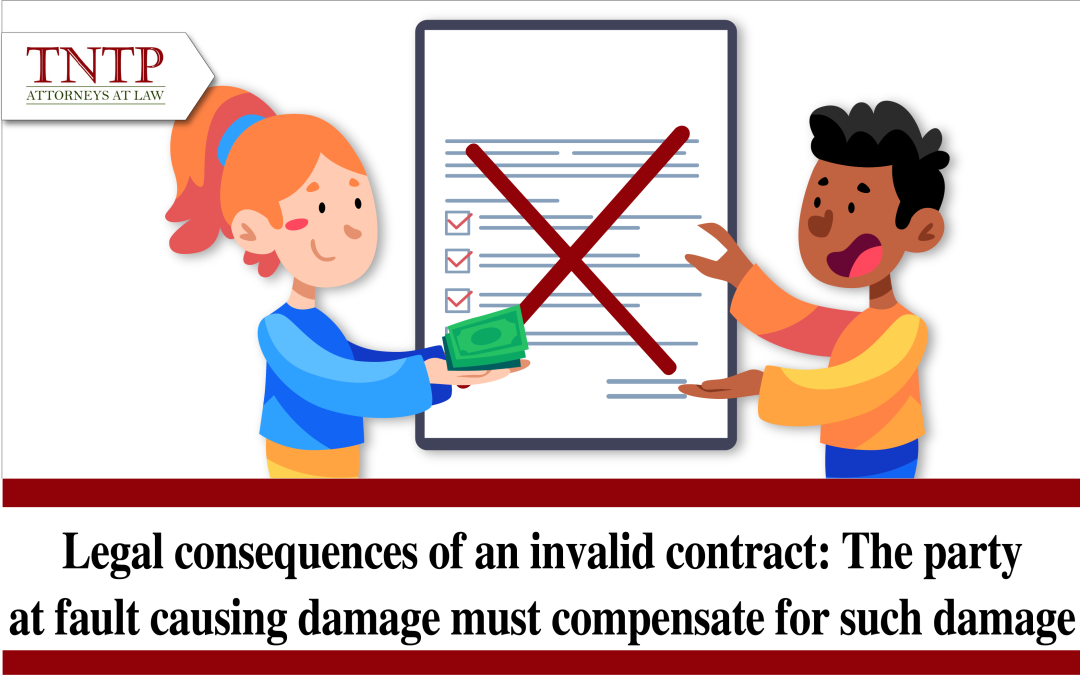When a contract fails to satisfy the legal requirements for validity prescribed by law, it may be declared invalid, thereby triggering various legal consequences. In addition to the obligations of restoring the original status and returning the assets or benefits already received, another crucial consequence that demands particular attention is the obligation of the party at fault to compensate the other party for damages incurred due to the invalidation of the contract. The determination of damages resulting from an invalid contract must be based on actual and direct losses, taking into account the extent to which the contract was practically performed, as well as the fault of each involved party.
1. Obligation to compensate damages arising from an invalid contract
According to Clause 4, Article 131 of the 2015 Civil Code, the obligation to compensate damages arises only when actual damages occur as a result of the contract being declared invalid. Accordingly, the party whose fault led to the invalidation of the contract and thus caused damage is obligated to compensate the injured party.
2. Conditions for establishing liability for damages
Determining liability for damages arising from an invalid contract involves two fundamental considerations: Identifying the actual and direct damages sustained by the injured party and assessing the fault of the involved parties in causing those damages.
i) Actual and direct damages
Liability for damages from an invalid contract arises solely concerning actual and direct losses directly linked to the invalidation of the contract. Current Vietnamese law does not explicitly regulate specific types of damages directly compensable in cases of invalid contracts; therefore, judicial practice commonly applies principles analogous to those governing cases of contractual breach. Specifically, in cases involving contractual breaches, actual and direct damages typically include five categories: property loss; reasonable expenses incurred to prevent, limit, or remedy the damage; actual income losses or reductions; benefits expected from contract performance; and other expenses arising from contractual non-performance that do not overlap with the expected contractual benefits.
Referring to Resolution No. 01/2003/NQ-HDTP and Resolution No. 02/2004/NQ-HDTP issued by the Judicial Council of the Supreme People’s Court concerning invalid contracts for land-use rights transfer or housing sales, actual and direct damages include:
• The difference between the property’s value determined at the time of the first-instance trial and the value initially agreed upon by the parties. Accordingly, the guidance provided in the two aforementioned Resolutions serves merely as orientation and does not preclude the possibility that the involved parties may request a re-evaluation of the asset’s value at subsequent judicial levels, such as appellate or cassation proceedings, should they disagree with the first-instance judgment and pursue further litigation at higher levels.
• Expenses incurred by the seller to restore the returned asset to its original condition (e.g., repair costs if the buyer damaged the asset). The guidelines in the above-mentioned Resolutions are to be understood as merely advisory and do not exclude other reasonable expenses necessary to prevent or mitigate damages, if any.
• Amounts invested by the purchaser to improve or increase the asset’s value compared to its original state (e.g., construction of additional structures on the property).
There is an opinion that compensable damages in the event of contract invalidation do not encompass expected profits or hypothetical benefits that would have accrued if the contract had remained valid. At the time of contract formation, these benefits were speculative and had not materialized. Since the primary objective upon contract invalidation is to restore the parties to their original state as if no contract had been formed, claiming hypothetical benefits is legally inappropriate and contradicts the purpose of restoring the initial conditions.
ii) Degree of contract performance
According to the guidance in Resolutions No. 01/2003 and 02/2004, when determining compensation liabilities arising from invalid contracts, the actual extent to which the contract has been performed must be considered. As a fundamental principle, compensable damages must be actual and directly attributable to the invalidation. Thus, if the parties have only partially fulfilled their contractual obligations, damages will be assessed proportionally to the extent of actual performance, rather than based on the full contractual value initially agreed upon by the parties.
iii) Fault of the involved parties
Upon declaration of contract invalidity, fault may arise from one party, both parties, or neither party. Under the 2015 Civil Code, where one or both parties are at fault in causing the invalidation and subsequent damages, liability for compensation will be determined according to the degree of fault of each party. Based on Resolutions No. 01/2003 and 02/2004, three scenarios may be distinguished clearly:
• First scenario: If the injured party is entirely free from fault, the party at fault shall be liable to compensate the total damages incurred due to contract invalidation.
• Second scenario: If the injured party is entirely at fault for the invalidation, the other party is exempt from liability to compensate damages.
• Third scenario: If both parties share fault in the invalidation, liability for damages is allocated proportionately to their respective degrees of fault. In cases where fault is evenly distributed, each party bears an equal share of liability.
3. Judicial practice
In practice, determining compensation liabilities for invalid contracts is often challenging, particularly in complex disputes involving real estate or intangible assets. For example, if the purchaser constructs additional buildings on land subsequently subject to invalidation due to non-compliance with statutory conditions, courts must carefully assess asset values before and after improvements, reasonable restoration costs, and subjective faults of involved parties.
Furthermore, assessing each party’s fault and determining their respective degrees of fault are frequently problematic, given that fault assessment must rely upon the parties’ subjective intentions at the time of contract formation. As subjective intentions are inherently challenging to discern, courts typically rely upon objective behaviors and external manifestations exhibited by the parties throughout the contracting process to infer their true intent. Specifically, fault assessment for damage compensation hinges upon parties’ violations at the contract formation stage. For instance, if a party knew or should have known the contract risked invalidation due to non-fulfillment of statutory requirements, yet intentionally proceeded with its formation or purposefully induced the other party to enter into the agreement, such conduct can substantiate fault attribution in causing damage due to contract invalidation.
The above translation, “Legal consequences of an invalid contract: The party at fault causing damage must compensate for such damage”, is respectfully provided to readers by TNTP. We hope this article offers valuable insights.
Best regards,







